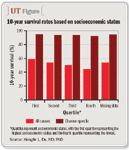Article
Socioeconomic differences affect prostate cancer survival
Houston-Socioeconomic status correlates strongly withmortality in older American men with local/regional stage prostatecancer and is a major factor contributing to the disparity insurvival between African-Americans and Caucasians, according to theresults of a study published recently in Cancer (2006;106:1276-85).

The population-based investigation included a nationwide sample of 61,228 Medi-care beneficiaries (age 65 years and older) di-agnosed with local or regional stage prostate cancer between 1992 and 1999. There were 53,764 Caucasians, 1,143 Hispanics, and 6,321 African-Americans in the cohort. Post-diagnosis follow-up ex-tended to 11 years with a minimum of 3 years in all men.
The effect of socioeconomic status on outcome was explored us-ing four variables (pov-erty, income, education, and a composite integrating all three) in statistical models that also adjusted for age, tumor stage, Gleason score, treatment, comorbidity, year of diagnosis, and geographic area.

However, analyses of data for the pooled population identified statistically significant relationships between low socioeconomic status and reduced survival. When the outcomes analyses controlled for socioeconomic factors, racial/ethnic disparities in survival/mortality risk were reduced or even completely eliminated.
"The results of this study indicate that previously described racial differences in prostate cancer survival may be largely explained by the socioeconomic differences between African-Americans and Caucasians," said lead author Xianglin L. Du, MD, PhD, associate professor in the School of Public Health, division of epidemiology, University of Texas Health Science Center at Houston.
"Those socioeconomic differences, in turn, may reflect differences in many other factors, including education, housing, nutrition, and access to good health care. Targeting those disparities will likely be important for ensuring all patients receive optimal treatment and ensuring the best possible outcomes for all men with pr-ostate cancer."
While a large number of previous studies suggested socioeconomic factors played a major role in differences in outcomes between Caucasian and African-American men with prostate cancer, there were also some conflicting results as well as a paucity of information regarding that interaction among Hispanic men. To further explore race/ethnicity and socioeconomic status as factors in prostate cancer survival, Dr. Du and colleagues used data from the National Cancer Institute's population-based Surveillance, Epidemiology, and End Results (SEER) cancer registry that covers 11 catchment areas across the 48 continental United States and Hawaii.
All of the men were Medicare recipients with Parts A and B coverage, and information on tumor stage, grade (Gleason score), treatment, and comorbidities was derived from the SEER-Medicare claims data. Socioeconomic status for each man was defined by census tract or zip code.
"Our use of the SEER and Medicare databases represents a major strength of this study, as it featured a very large, nationwide sample, reliable data on tumor features and survival, and complete information on comorbidities and treatments. However, as a limitation, we did not have individual data on socioeconomic features, and we also lacked information on other factors that might affect outcome, such as physician and hospital characteristics and patient preferences regarding treatment," Dr. Du told Urology Times.
Categorization for socioeconomic status was performed by dividing each of the individual factors and the composite variable into quartiles. For each of the four socioeconomic variables, there were higher proportions of African-American and Hispanic men in the lowest quartiles compared with the Caucasians, and the differences in distribution between Caucasians and the other two study groups were statistically significant. Considering the composite factor as an example, only 17% of Caucasian men were in the lowest quartile compared with 71.6% of African-Americans and 57.8% of Hispanics.





